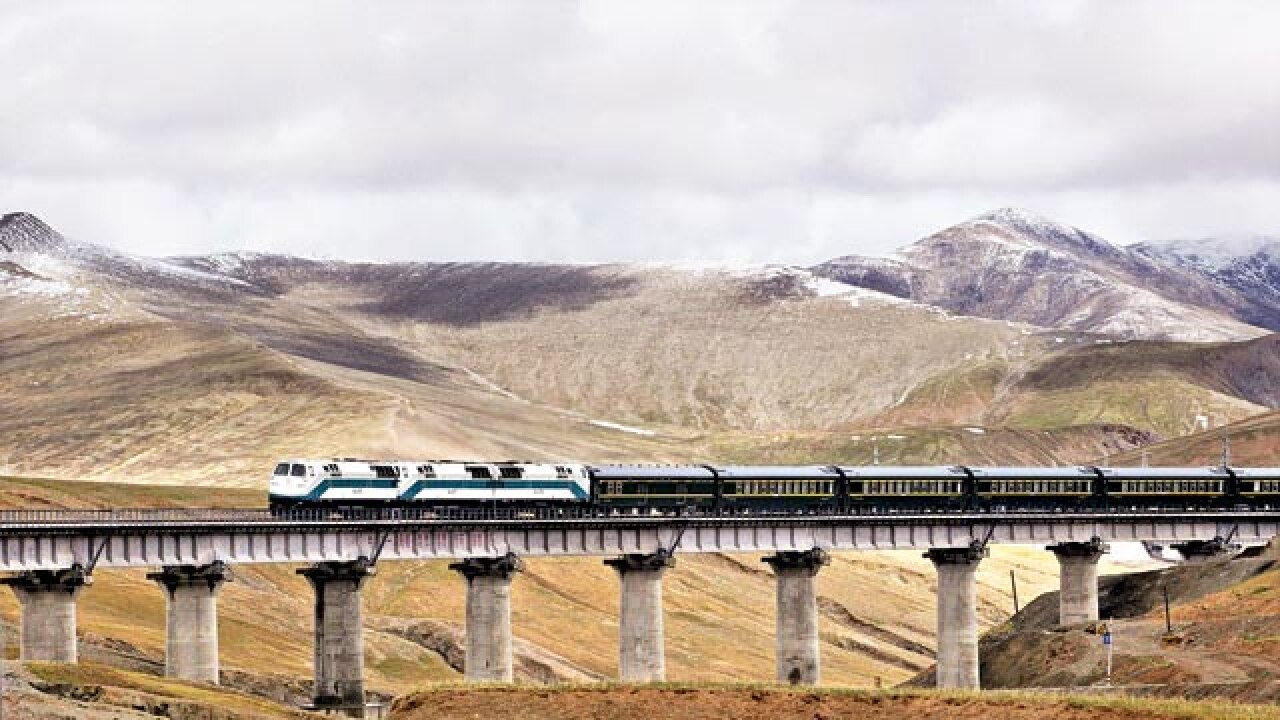
The Qinghai-Tibet Railway (QTR) line in China has completed a decade this summer, since the time it became fully operational on July 1, 2006. Running initially from Golmud in the Qinghai province to Lhasa, this maiden railway line in Tibet managed to connect and integrate the Tibetan plateau with the rest of Mainland China. With Qinghai placed in the Tibetan highlands as a desolate plateau, the rail line has been constructed in the highest region on earth, at an average elevation of 4,900 metres (16,000 ft). Incidentally, the launch of the QTR in 2006 coincided with the 85th anniversary of the founding of the Chinese Communist Party as well as the 10th anniversary of the reversion of Hong Kong from British to Chinese sovereignty.
The QTR has further been extended by virtue of inauguration of the second railway line in Tibet in 2014, now extending from the provincial capital Lhasa further up to Shigatse, the second-largest city in Tibet, located southwest of Lhasa. With the completion of the second leg, the Golmud-Lhasa-Shigatse railway line remains the pivot of China’s Great Western Development policy, aimed at promoting the larger cause of Chinese nationalism and “great power status” by means of enhanced economic development of the underdeveloped western region, which primarily remains populated by ethnic minority communities — most significantly, the Tibetans.
Today, Tibet’s annual GDP is growing at 11.9 per cent a year. A substantial portion of these growth figures goes to the past four decades, wherein the Chinese government steadily escalated its mining activities on the plateau, and the railway line simultaneously proving instrumental in expediting Chinese efforts to transport mineral resources from Tibet to the Chinese mainland on a cost-effective basis. The Qinghai-Tibet Railway has 18 loading stations in industrial zones and at coal bases, with trains carrying industrial salt, fertiliser, alkali, coal, aluminium and iron ore from the Tibetan Plateau. To be underscored is that Tibet has proven deposits of 126 minerals, with a significant share of global reserves of uranium, lithium, chromite, copper, borax, and iron.
With a train ticket from Beijing to Lhasa ranging anywhere from 360 to 1,144 yuan ($54–$172) tourism, too, has seemingly surged as visitors to the region exceeded 20 million, bringing in 28 billion yuan in revenue for local herders and farmers along the rail line — thereby aiding in transforming the local economy. Often hailed as the highest railway line in the world, as well as the longest built rail link on a single plateau, the 1,956 km rail has carried 115 million passengers and moved 448 million tonnes of goods, as of this summer, according to the China Railway Corp.
However, building this rail line did confront its share of arduous challenges including permafrost, wildlife preservation, and sewage treatment aboard trains. The Tibetan Plateau’s ecosystem is extremely fragile that shelters some of the most unique and endangered animal species, grasslands and forests that are fast degrading owing to the increasing burden of urbanisation and infrastructure stack-up forced on it by China.
Nearly 550 kms of the total railway track is laid on permafrost, frozen soil, sediment or rock. The biggest challenge was posed by permafrost, ie, ground that stays frozen for a minimum of two years. This was overcome by elevating the track with pile-driven foundations that were sunk deep into the ground in permafrost areas. Besides, a total of 10,829 heating pipes have been placed underground that keep the tracks clear of ice and snow.
Presently making stoppages at three stations namely, Xining, Golmud, and Lhasa, the rail line has five additional stations that are currently undergoing construction.
While all the above statistical data does hold ground, to label construction of the Tibetan rail line as a completely “indigenous engineering marvel,” by China is not entirely accurate. It has to be acknowledged that completion of the rail line could not have been accomplished, had it not been for the US General Electric’s NJ2 diesel electric locomotives manufactured in Erie, Pennsylvania, which were specially customised to run on the oxygen-deficient, high altitude, Tibetan Plateau. The GE engines maintain an average speed of 100 kms per hour, even at altitudes over 4,000 mts, where the thin air can have a halving effect. Further, Quebec-based transportation giant Bombardier, which fulfilled a $280 million contract to build carriages that can withstand the journey through Tibet’s frozen mountains, have also been instrumental in China achieving this technological feat.
The QTR rail line for sure has boosted Tibet’s economic and social development and concurrently served as a dual-use tool for China to ensure tight-fisted political and military control over the Tibet Autonomous Region — which constitutes nearly one-fourth of China’s total landmass. Tibet’s security implies securing China’s western frontier. Given that more than 2 per cent of the entire railway line is made up of tunnels, it has been assessed that some of the tunnels along this rail line could well have been reserved to be used as secure storage sites or bases for rail mobile missiles.
It is has been estimated that by the end of 2016, there will be nearly 20 million Han Chinese residing in Tibet, thereby eroding the cultural boundaries and ethnicity of the Tibetan people. By building settlements at every 60 km along the Tibetan rail line that predominantly inhabits the Han Chinese, indications of the growing Han lifestyle and predominance in Lhasa are becoming far more discernible. With nearly 50,000 cadres, demobilised annually, being encouraged to settle in the Tibetan region, China’s “Go West” campaign provides major fiscal incentives and is seen to be injecting a considerable demographic makeover of the entire Tibet Autonomous Region.
The author is a Senior Fellow at the Centre for Land Warfare Studies, New Delhi, where she heads the China-study programme